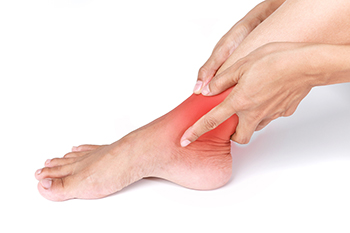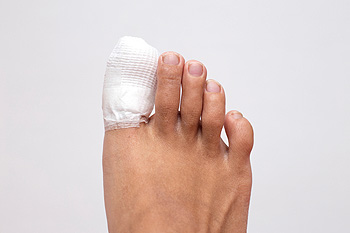Items filtered by date: June 2022
Big Toe Fusion May Help Arthritic Patients

Patients who have arthritis in their big toe may find relief by having toe surgery performed. A big toe fusion can help relieve stiffness, swelling, and inflammation that often accompanies arthritis. Some of the benefits that are associated with this type of surgery include a general feeling of well-being, permanent reduction in big toe pain, and stability due to the use of screws, wires, pins, and metals. Additionally, wearing shoes will gradually become a comfortable experience. Some patients refrain from having this type of surgery performed. This may be because of the inability to push off with the big toe while taking a step and the nerves can be affected which may cause numbness. A condition that is referred to as a malunion occurs when the toe heals in the wrong position. Despite the cons of having this type of joint replacement surgery performed, many patients are satisfied with the result. If you have arthritis in your big toe, please confer with a podiatrist who can determine if this surgery is right for you.
In certain cases, in which the patient suffers from extreme pain or damage in a joint, joint replacement surgery may be deemed useful. If you have constant pain in a foot joint, consult with Donald Manger, DPM from Associated Podiatric Physicians, PA. Our doctor will assess your condition and provide you with quality foot and ankle treatment.
What Is Joint Replacement Surgery?
Over time, joints wear down; this can be exacerbated by diseases and conditions. Joint replacement surgery, also known as arthroplasty, is when a damaged joint is surgically removed and replaced with a prosthesis. Prostheses, which can be made of ceramic, plastic, or metal, act as joints in lieu of an actual joint. One of the most prevalent causes for joint replacement is arthritis.
Arthritis in the Foot
Arthritis can occur in any joint in the body, including in the feet. Common types of arthritis in the foot are osteoarthritis, rheumatoid arthritis, and gout. The big toe is usually where arthritis occurs in the foot; this is known as hallux rigidus.
Joint Replacement Surgery in the Foot
The most common form of joint replacement in the foot is a first metatarsophalangeal (MTP) joint placement. MTP joint replacement surgery is designed to treat hallux rigidus. Surgery is not intensive, and recovery occurs within one to two months after the procedure has been done. Overall, joint replacement surgery is a safe and effective way to treat pain in the joint of the foot.
If you have any questions, please feel free to contact our office located in Hamilton Township, NJ . We offer the newest diagnostic and treatment technologies for all your foot care needs.
Do Your Child's Feet Hurt?
Ankle Pain That Is Not From an Injury

If your ankle hurts and you cannot recall doing anything that might have caused it, it could be a result of a type of arthritis, an autoimmune condition, or an infection. Obviously, the best treatment will depend on the root cause of the pain. Osteoarthritis is when the cartilage cushion between two bones gradually wears away, causing the bones to rub against each other. This might be painful, particularly upon arising, and it can come on suddenly. Rheumatoid arthritis is a chronic autoimmune disease when your body’s immune system begins attacking healthy tissue, including the lining of your ankle joints. This type of arthritis also causes pain, in addition to swelling and stiffness that begin in the toes and move toward the ankles. Fallen arches are when the tendons supporting the arches of the feet get damaged, the arches lose support and fall. An infection starting in a different part of your body may settle in the ankle joint. Any one of these ailments can cause ankle pain. If you feel such pain and believe you have not sustained an ankle injury, it is important to consult with a podiatrist for a proper diagnosis and treatment for the underlying cause.
Ankle pain can have many different causes and the pain may potentially be serious. If you have ankle pain, consult with Donald Manger, DPM from Associated Podiatric Physicians, PA. Our doctor will assess your condition and provide you with quality foot and ankle treatment.
Ankle pain is any condition that causes pain in the ankle. Due to the fact that the ankle consists of tendons, muscles, bones, and ligaments, ankle pain can come from a number of different conditions.
Causes
The most common causes of ankle pain include:
- Types of arthritis (rheumatoid, osteoarthritis, and gout)
- Ankle sprains
- Broken ankles
- Achilles tendinitis
- Achilles tendon rupture
- Stress fractures
- Tarsal tunnel syndrome
- Plantar fasciitis
Symptoms
Symptoms of ankle injury vary based upon the condition. Pain may include general pain and discomfort, swelling, aching, redness, bruising, burning or stabbing sensations, and/or loss of sensation.
Diagnosis
Due to the wide variety of potential causes of ankle pain, podiatrists will utilize a number of different methods to properly diagnose ankle pain. This can include asking for personal and family medical histories and of any recent injuries. Further diagnosis may include sensation tests, a physical examination, and potentially x-rays or other imaging tests.
Treatment
Just as the range of causes varies widely, so do treatments. Some more common treatments are rest, ice packs, keeping pressure off the foot, orthotics and braces, medication for inflammation and pain, and surgery.
If you have any questions, please feel free to contact our office located in Hamilton Township, NJ . We offer the newest diagnostic and treatment technologies for all your foot care needs.
Simple Methods That May Help to Prevent Running Injuries

Many people who enjoy running can experience a small amount of normal discomfort. This may be from strengthening the heart and leg muscles. Additionally, there are people who have persistent pain, and this is something that requires immediate attention. An improper running form or increasing distance and intensity too soon could result in injury. A common foot injury that affects the heel is known as plantar fasciitis, and this can cause difficulty in walking. There are simple methods that can help prevent running injuries. These methods consist of wearing shoes that fit correctly, in addition to avoiding running on uneven surfaces. Many runners can experience a stress fracture which is a hairline fracture. This type of injury is often ignored and can lead to severe pain and discomfort. This condition may be prevented by properly warming up and cooling down before running. An ankle sprain generally requires running to be stopped temporarily so an effective healing process can take place. If you would like more information about how to prevent running injuries, please confer with a podiatrist.
All runners should take extra precaution when trying to avoid injury. If you have any concerns about your feet, contact Donald Manger, DPM of Associated Podiatric Physicians, PA. Our doctor will treat your foot and ankle needs.
How to Prevent Running Injuries
There are a lot of mistakes a runner can make prior to a workout that can induce injury. A lot of athletes tend to overstretch before running, instead of saving those workouts for a post-run routine. Deep lunges and hand-to-toe hamstring pulls should be performed after a workout instead of during a warmup. Another common mistake is jumping into an intense routine before your body is physically prepared for it. You should try to ease your way into long-distance running instead of forcing yourself to rush into it.
More Tips for Preventing Injury
- Incorporate Strength Training into Workouts - This will help improve the body’s overall athleticism
- Improve and Maintain Your Flexibility – Stretching everyday will help improve overall performance
- “Warm Up” Before Running and “Cool Down” Afterward – A warm up of 5-10 minutes helps get rid of lactic acid in the muscles and prevents delayed muscle soreness
- Cross-Training is Crucial
- Wear Proper Running Shoes
- Have a Formal Gait Analysis – Poor biomechanics can easily cause injury
If you have any questions, please feel free to contact our office located in Hamilton Township, NJ . We offer the newest diagnostic and treatment technologies for all your foot care needs.
Buddy Taping May Be a Possible Treatment Method

When patients incur a broken toe, their lives may change temporarily. It may be difficult to walk, and completing daily activities can be challenging. The common symptoms that many people experience with a broken toe can include extreme pain and tenderness, bruising, and swelling. Severe breaks will often display a bone that protrudes through the skin. A broken toe is often the result of a heavy object dropping on it, or being stubbed against a piece of furniture. Relief may come from resting the affected toe, and taping it to the toe next to it. This is referred to as buddy taping, and can be a successful method in providing the stability that is needed as the healing process occurs. Many broken toes are diagnosed by having X-rays taken, and this is helpful in determining the severity of the fracture. A boot or cast may be prescribed for severe breaks, and this can help to alleviate pressure that is put on the toe. If you have broken your toe, it is advised that you seek the counsel of a podiatrist who can help you to treat your it properly.
A broken toe can be very painful and lead to complications if not properly fixed. If you have any concerns about your feet, contact Donald Manger, DPM from Associated Podiatric Physicians, PA. Our doctor will treat your foot and ankle needs.
What to Know About a Broken Toe
Although most people try to avoid foot trauma such as banging, stubbing, or dropping heavy objects on their feet, the unfortunate fact is that it is a common occurrence. Given the fact that toes are positioned in front of the feet, they typically sustain the brunt of such trauma. When trauma occurs to a toe, the result can be a painful break (fracture).
Symptoms of a Broken Toe
- Throbbing pain
- Swelling
- Bruising on the skin and toenail
- The inability to move the toe
- Toe appears crooked or disfigured
- Tingling or numbness in the toe
Generally, it is best to stay off of the injured toe with the affected foot elevated.
Severe toe fractures may be treated with a splint, cast, and in some cases, minor surgery. Due to its position and the pressure it endures with daily activity, future complications can occur if the big toe is not properly treated.
If you have any questions please feel free to contact our office located in Hamilton Township, NJ . We offer the newest diagnostic and treatment technologies for all your foot and ankle needs.

